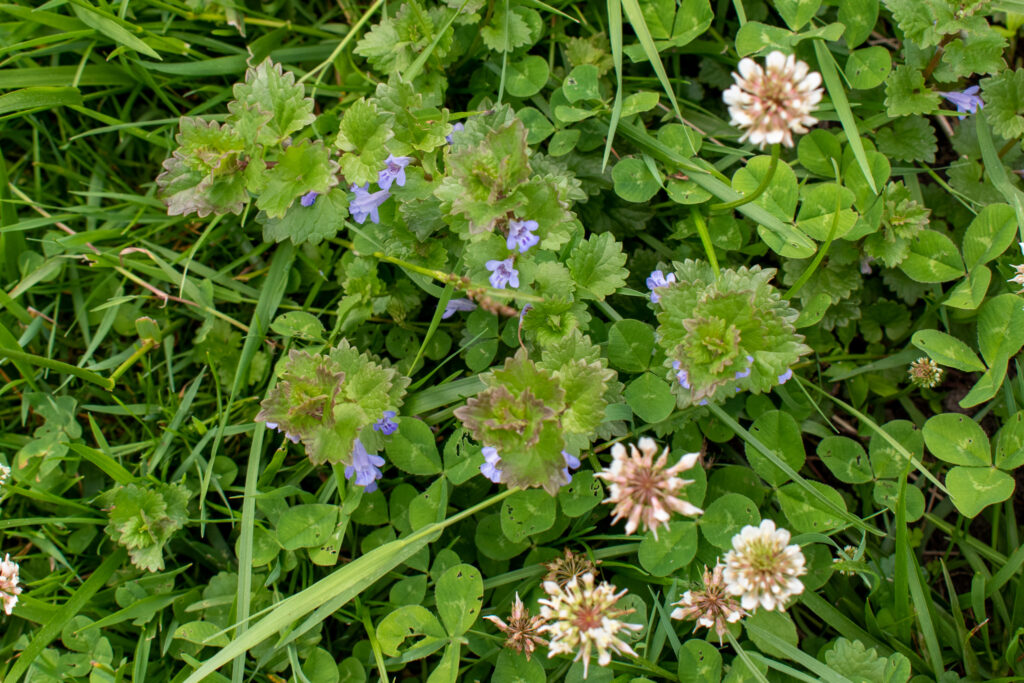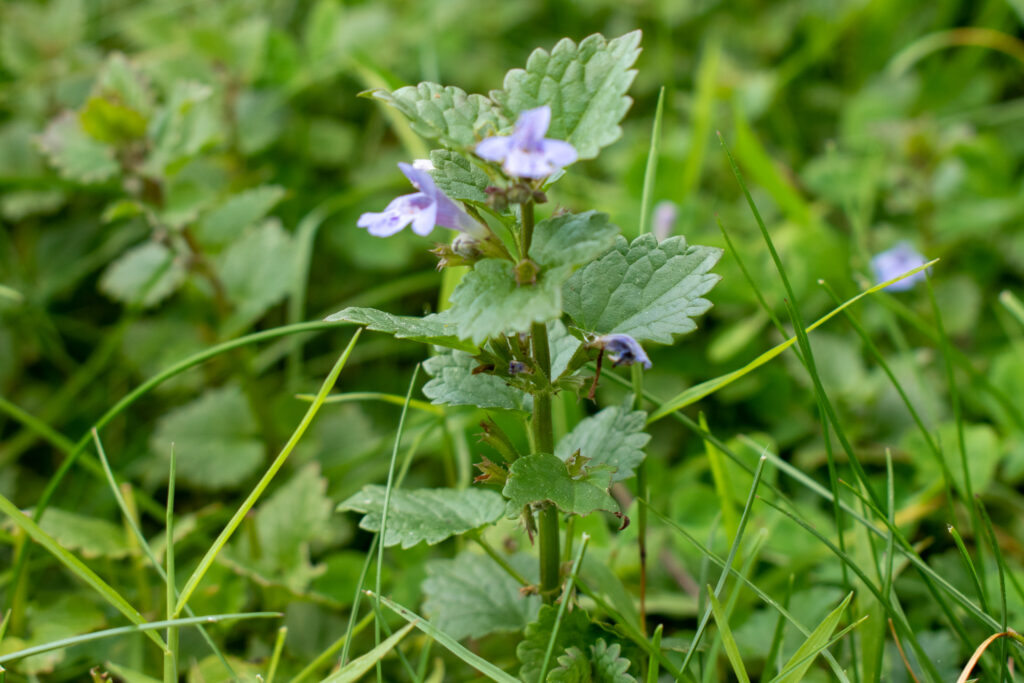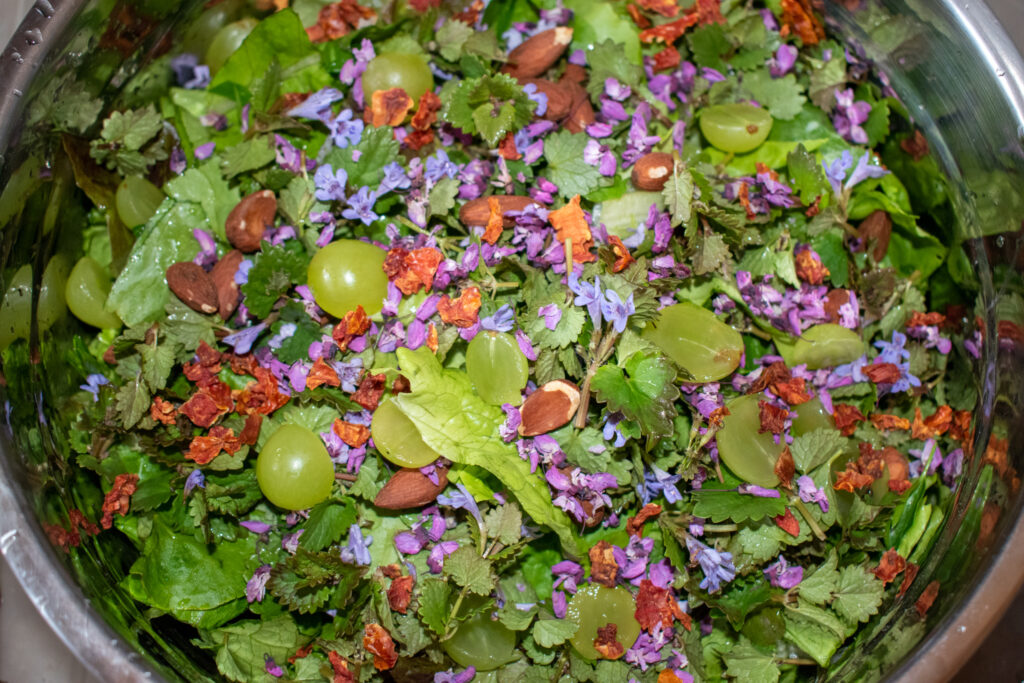Ground Ivy

Growing gardens is hard work. You have to do research, shop for equipment, put in the beds, watch the weather, start seeds, prepare beds, plant, weed, water, watch some more weather, weed some more, harvest, etc. The list goes on. I love to garden and I my kids love for me to find simpler ways to garden but I REALLY love when food grows itself and all I have to do is walk outside and pick it.
Ground Ivy is the first in our “Eat Your Yard” series where we will explore the plants that many of us have growing in our yard or common areas whether we know it (or want it) or not. Let’s dig a little into what this plant is and why we can rejoice over its presence in our lives and put it to good use!
Identifying Ground Ivy

The scientific name is Glechoma hederacea. It is in the mint family, with it’s characteristic square stem and prolific growth habit, but they lack the minty flavor. It goes by many common names besides Ground Ivy. People also refer to it as Creeping Charlie, gill-over-the-ground and alehoof among others.
It grows as tall as 20 inches but can also thrive in the 3 inch range when growing in areas subject to mowing. Leaves are about an inch in diameter, round to kidney shaped with crenolated edges and grow opposite one another on the stem. You may see roots at the leaf nodes as Ground Ivy has a “creeping” babit.
Finding Ground Ivy
Ground Ivy likes moist, rich, disturbed soil. It prefers some shade but can also tolerate sun. It can be found in woodlands, hedgerows, road sides, untreated fields and it loves cropping up in gardens and flowerbeds where it can form a dense mat which is difficult to irradicate as a brief search of “Ground Ivy” online will reveal! It is persistent and invasive (I prefer the term “abundant”) when established.
It is non-native in North America, probably brought by European settlers from their home countries where it was valued as an culinary and medicinal herb. It has a distinctive odor when crushed and isn’t subject to insect damage.

There are no poisonous plants that closely resemble the Ground Ivy so there is little danger from mis-identifying the plant. Two of the plants sometimes confused with Ground Ivy (and which often co-habitate with it) are Purple Dead Nettle and Henbit. Check out this great article on how to distinguish these three plants. As always, positively ID any plant before consuming it. When you introduce a new food to your diet you should proceed with common sense. Eat a few leaves first and check for any adverse reaction before making an entire meal out it!
Medicinal Uses
The following is for informational purposes only and is not intended to diagnose or treat any diseases. Consult your doctor before consuming any herbs medicinally.
Glechoma hederacea has been used in European medical tradition for thousands of years. It was commonly believed to be beneficial to lung and breathing related issues (e.g. bronchitis). Ground Ivy was also considered to be a diuretic (helping the body get rid of excess retained water) and therefore possibly benefiting kidney cleansing. It’s leaves can also be used topically to treat wounds as it is mildly anti-bacterial and anti-fungal.
In the Kitchen
Ground Ivy is green year round and can even be harvested from under the snow. While the whole plant is edible, for fresh eating you’ll want to avoid the fibrous stem and just pinch off the top part of the plant with the abundant leaves and the flowers. Because of that “abundant” nature, it typically takes only moments to fill a bowl with the lovely stuff. We harvest mostly low-growing ones from our yard, so we give them a rinse and they’re ready to be added to numerous dishes.

Ground Ivy is high in iron and rich in vitamins. It has a mild flavor with hints of floral notes that works well in teas, especially when paired with plants that have a more robust flavor profile like sumac or dandelion.
In our house Ground Ivy adorns almost every salad as it is prolific and can be harvested year round. The blue/purple blooms add a pop of color and texture as well as a nutritional profile much fuller than the lettuces they top.
Traditionally, Ground Ivy was used in preserving the life and improving the flavor of home brews. Hence the many common beer-related common names (gill-over-the-ground, alehoof, etc.) Interestingly, it was also used in place of animal rennet in cheese making (this is on my to-do list, both making my own animal rennet and trying this vegetable substitute).
Though Ground Ivy is in the mint family it doesn’t have any of the “minty” smell.

I hope that you will keep an eye out for this beneficial and delightful garden neighbor in your yard and rather than looking for Roundup, run for your salad bowl. When you do, be sure to check out our fab recipe for a sweet-savory Carrot Ginger Sesame Dressing that complements a salad rich in herby flavors!
The Do’s of Wild Harvesting
Any time you’re harvesting wild plants whether on your own land, some eles’s private land, or on public land, there are some basic principles to follow to ensure that you’re foraging does no harm to the ecosystem, animal habitats or yourself.
DO:
- Follow applicable laws. Obtain permits for harvesting off public land and explicit permission per species from a private owner. When you get permission, offer to share the bounty.
- Positively identify any plant harvested for consumption. Many herbs and mushrooms have toxic look-alikes which can harm or kill your or your family if consumed accidentally.
- Leave plenty in place! Never take all of any species from an area. A good rule of thumb is to leave at least nine for every one you harvest. Many pollinators may rely on the flowers, and insects can be very specific in their plant host needs. If there are only a few, let them be and find out how to encourage their growth! To never harvest endangered species goes without saying!
- Harvest only the part of the plant required. Many herbs will grow in bushier and stronger if pinched at the tops and the roots and bottom leaves are left in tact.
- Harvest at the appropriate time of year. Some species are healthful at certain times and should be avoided at other times. Be familiar with good practices for harvesting a particular plant. Even the time of day can make a difference in the nutritional value of the harvest in some cases.
- If you use any tools, make sure they are clean and don’t harvest/touch any plants that are not in the peak of health. You don’t want to spread disease.
- Stay away from high traffic roadsides and industrial areas. Water and air are often polluted and the plants growing nearby may not be suitable for consumption. Powerlines are also often sprayed with herbicides and should be avoided.
- Encourage “wild ares” in your own landscaping and avoid any unnecessary pesticide or herbicide use. Multi-species plantings are almost always healthier for the micro-environment and the individual species than single species areas like weed-free lawns. You might be surprised at the riches that spring up naturally and the increased bird and beneficial insect traffic.
